Stripe Bundle
How Does Stripe Dominate the Digital Payments Landscape?
In the ever-evolving digital economy, understanding the Stripe SWOT Analysis is crucial for investors and businesses alike. Stripe's innovative approach to sales and marketing has propelled it to the forefront of financial infrastructure. This article explores the strategies behind Stripe's remarkable growth, from its developer-centric beginnings to its current status as a global payment processing powerhouse. We'll dissect the tactics that have made Stripe a leader in the industry.
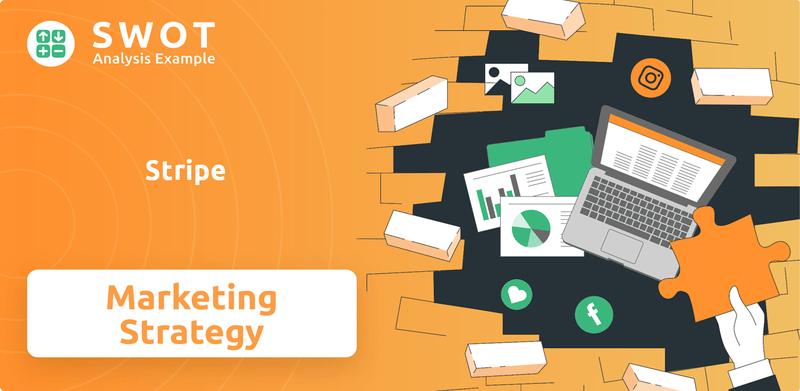
Stripe's success stems from a potent combination of a robust Stripe business model, effective Stripe marketing strategy, and a streamlined Stripe sales strategy. Analyzing its customer acquisition cost and the efficiency of its marketing channels reveals valuable insights for anyone aiming to understand the company's competitive advantage. This deep dive will uncover how Stripe leverages its sales process, partnerships, and integrations to maintain its impressive market share and drive future growth. We will also explore Stripe's marketing campaign analysis and pricing strategy.
How Does Stripe Reach Its Customers?
The sales channels employed by Stripe are multifaceted, reflecting its evolution from a startup-focused payment platform to a comprehensive financial infrastructure provider. Its approach is tailored to meet the needs of diverse customer segments, from small businesses to large enterprises. Stripe's sales strategy is designed to facilitate easy onboarding and seamless integration, driving its growth and market penetration.
Stripe's primary sales channel is direct, leveraging its website for self-service onboarding. This approach allows businesses to quickly set up and begin accepting payments. For larger clients, the company deploys direct sales and onboarding teams. Strategic partnerships and integrations also play a crucial role in expanding its reach and offering value-added services.
Stripe's business model is built on providing accessible and scalable payment solutions, making it a key player in the payment processing industry. This strategy has allowed Stripe to capture a significant market share and maintain a competitive advantage. The company's focus on developer-friendly tools and robust documentation has been instrumental in attracting and retaining customers.
Stripe's website serves as a primary sales channel, providing self-service onboarding. This allows businesses to quickly set up and accept payments online. This approach is particularly effective for startups and developers, who can easily integrate Stripe's APIs.
For larger businesses, marketplaces, or platforms with complex needs, Stripe engages direct sales and onboarding teams. These teams conduct a comprehensive discovery process to understand the specific requirements of each client. This personalized approach ensures that larger clients receive tailored solutions.
Stripe actively pursues strategic partnerships and integration deals to expand its reach. Partnerships with companies like Shopify automatically include Stripe as a payment option for merchants. These collaborations enhance Stripe's market penetration and provide value-added services.
Stripe leverages its App Marketplace to offer additional services and integrations. The marketplace has more than doubled its listings to 150, including new apps for Chargeflow, Adobe Commerce, Salesforce CPQ, and NetSuite. This expands the functionality available to Stripe users.
Stripe's partnerships have significantly boosted its growth. For example, the expansion of the partnership with Klarna, making its buy now, pay later (BNPL) service available to Stripe merchants in 26 countries, doubled the number of new merchants adopting Klarna's services in Q4 2024. This partnership increased revenue for merchants by 14% through improved conversion rates and higher average order values.
- A partnership with SeQura in 2024, which integrated Stripe Connect into its BNPL infrastructure, contributed to a 55% year-over-year revenue growth for SeQura.
- Stripe's partnerships with e-commerce platforms like Shopify have made Stripe a default payment option for merchants.
- These integrations streamline the payment process and enhance the overall user experience.
- These strategic alliances are crucial for Stripe's sales and marketing strategy.
Stripe SWOT Analysis
- Complete SWOT Breakdown
- Fully Customizable
- Editable in Excel & Word
- Professional Formatting
- Investor-Ready Format
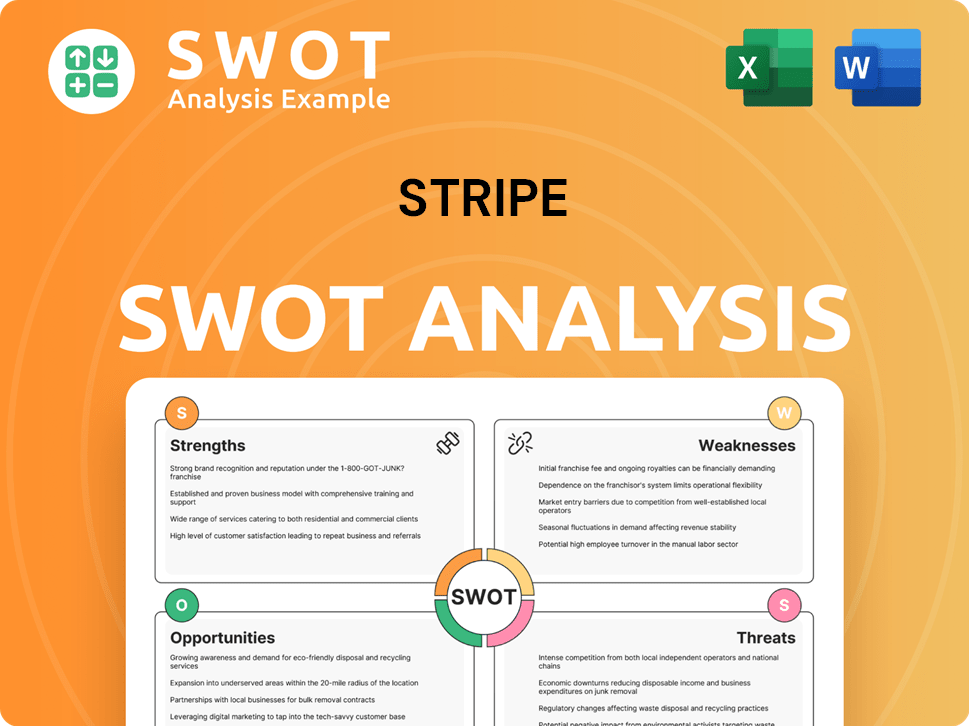
What Marketing Tactics Does Stripe Use?
The marketing tactics of the payment processing company are designed to build brand awareness, generate leads, and drive sales. Their approach is data-driven and customer-centric, focusing on understanding and meeting the needs of their target audience. This strategy includes a mix of digital marketing, developer-focused initiatives, and strategic events.
A core element of the company's marketing strategy is content marketing, which involves creating valuable content like tutorials and case studies to attract and engage developers and businesses. They also leverage SEO, paid advertising, and email marketing to reach their target audience effectively. Furthermore, they have a strong emphasis on developer marketing, providing a hands-on product experience and clear documentation.
The company's marketing efforts are heavily influenced by data analytics, allowing them to understand customer needs and market trends. This data-driven approach informs product development and strategic shifts. Moreover, their investments in AI have yielded significant results, with AI-powered fraud detection recovering a record $6 billion in false declines in 2024, a 60% year-over-year increase.
The payment processing company focuses on creating content that resonates with its developer audience. This includes providing tutorials, case studies, and user testimonials. This approach helps build trust and drives organic traffic to their platform, which is a key component of their Revenue Streams & Business Model of Stripe.
The company uses search engine optimization (SEO) to attract tech-savvy entrepreneurs and startups. Paid advertising, including early ads on platforms like Stack Overflow, is also part of their strategy. These targeted ads can be effective in reaching developers and driving traffic.
Email marketing is an essential part of their strategy to maintain contact and nurture leads. This helps in keeping potential customers informed about new features, updates, and other relevant information. It's a key tactic in their overall sales process.
A key element of their strategy is 'developer marketing,' which focuses on providing a hands-on experience with their product. This includes clear API documentation and self-serve sign-ups. This approach saves developers time and encourages adoption.
The company is highly responsive to customer feedback and problems, quickly addressing issues. This commitment to customer satisfaction helps build trust and loyalty. This is a crucial aspect of their customer acquisition cost strategy.
The company emphasizes social media marketing and hosts events, such as their annual Stripe Sessions, to connect directly with users. These events introduce new launches and gather feedback. This direct interaction is vital for understanding their market share.
The company uses analytics to understand customer needs and market trends, informing product development and strategic shifts. Their investments in AI models are delivering significant revenue and optimizing transactions. AI-powered fraud detection recovered a record $6 billion in false declines in 2024, a 60% year-over-year increase.
- Data analysis is used to understand customer behavior and market trends, which helps inform product development and strategic decisions.
- AI-powered fraud detection has significantly reduced financial losses, recovering $6 billion in false declines in 2024.
- The company's marketing strategy is constantly evolving based on data insights and technological advancements.
- The focus on developer marketing and providing a seamless user experience is a key part of their competitive advantage.
Stripe PESTLE Analysis
- Covers All 6 PESTLE Categories
- No Research Needed – Save Hours of Work
- Built by Experts, Trusted by Consultants
- Instant Download, Ready to Use
- 100% Editable, Fully Customizable
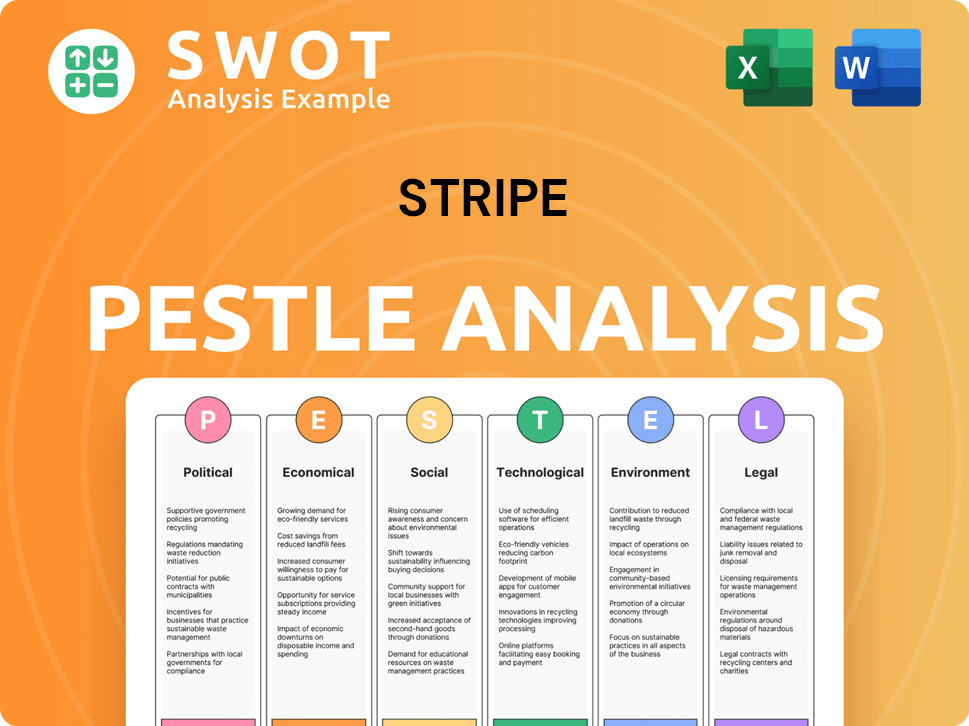
How Is Stripe Positioned in the Market?
Stripe's brand positioning centers on being the financial infrastructure platform for the internet economy. This positions the company as a crucial enabler for businesses, emphasizing its developer-friendly approach and comprehensive suite of financial services. The core message focuses on simplifying complex financial operations for businesses of all sizes, from startups to large enterprises, making it a versatile solution for a wide range of needs.
The visual identity and tone of voice are typically clean, technical, and professional, which resonates with a tech-savvy audience. Stripe's brand promises a seamless and secure payment experience, focusing on innovation, reliability, and scalability. This approach helps the company to stand out in the competitive landscape of Stripe's growth strategy.
The company differentiates itself by providing tools that enable businesses to move, transact, and monetize faster than competitors. It constantly invests in research and development to create cutting-edge solutions. This is evident in its strong adoption by technology companies; 75% of Forbes Cloud 100 companies use Stripe, and 60% of technology companies that went public in 2021 are Stripe customers.
Stripe's focus on developers makes integration easy. This approach provides flexibility and control, allowing businesses to customize solutions.
Stripe offers a broad suite of services, including payment processing, billing, and fraud prevention. This provides a one-stop-shop for financial needs.
Stripe continuously invests in R&D to create cutting-edge solutions. This approach ensures that they remain at the forefront of the industry.
The platform is designed to handle large transaction volumes, ensuring reliability. This is crucial for businesses of all sizes.
Stripe's reputation is also bolstered by its security and trust statistics, having been recognized by The Forrester Wave™ for Merchant Payment Providers (Q1 2024) and Recurring Billing Solutions (Q1 2025), and by Gartner. Brand consistency is maintained across various channels and touchpoints through its consistent messaging and user experience. Stripe responds to shifts in consumer sentiment and competitive threats by continually innovating and expanding its product offerings, such as its recent reintroduction of crypto payments with a focus on USDC, and its investment in AI-powered payment solutions. The company also highlights its broad customer base, including half of the Fortune 100 and long-established companies like Oxford University, the Church of England, and PepsiCo, which are modernizing their digital payments through Stripe, showcasing its versatility and appeal beyond just startups.
Stripe Business Model Canvas
- Complete 9-Block Business Model Canvas
- Effortlessly Communicate Your Business Strategy
- Investor-Ready BMC Format
- 100% Editable and Customizable
- Clear and Structured Layout
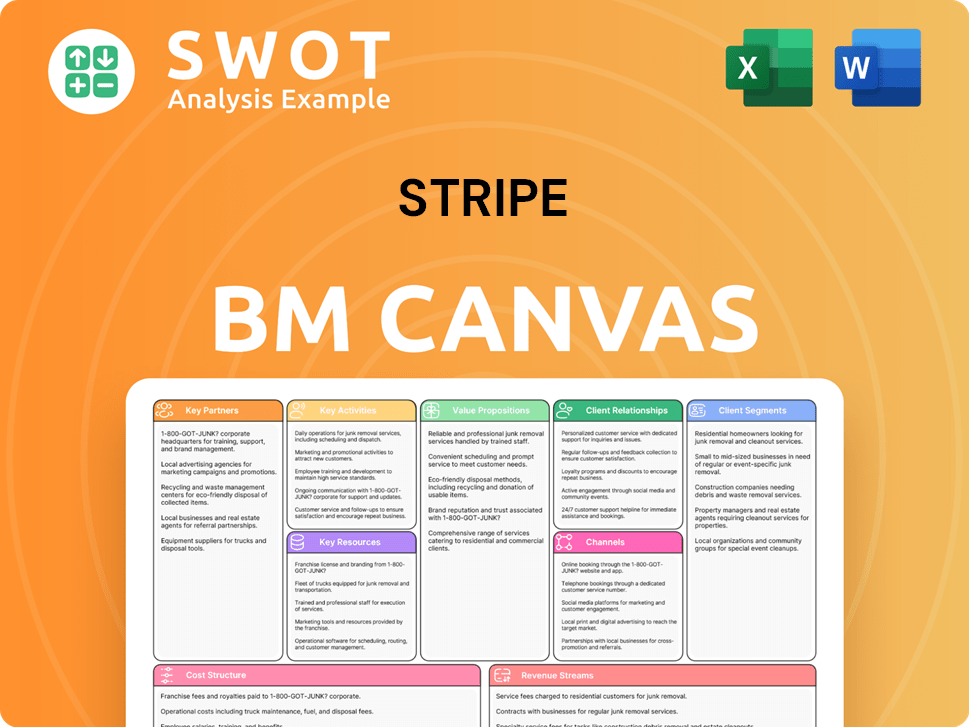
What Are Stripe’s Most Notable Campaigns?
The sales and marketing strategy of the payment processing company, often centers around demonstrating product value and fostering developer adoption, rather than traditional campaigns. However, certain initiatives and product developments have significantly driven growth and defined the brand. A key ongoing 'campaign' involves continuous investment in AI and stablecoins, which have been highlighted as critical for growth. These strategic moves, coupled with transparent communication, attract new businesses and reinforce its position as a leader in financial technology.
One of the primary aspects of the company's approach is its focus on partnerships. Strategic collaborations, such as the expanded global partnership with Klarna, enable businesses to offer BNPL services, boosting merchant revenue. Additionally, annual communications, like the February 2025 annual letter, serve as a 'campaign' by highlighting achievements and strategic directions. This approach, along with acquisitions like Bridge, positions the company at the forefront of blockchain-based payments.
The company's sales and marketing tactics are largely driven by product innovation and strategic partnerships. The company's growth is fueled by its ability to integrate new technologies and offer valuable services to its customers. This approach has helped the company maintain a strong competitive advantage in the payment processing industry. For a deeper understanding of the company's growth trajectory, consider exploring the Growth Strategy of Stripe.
Continuous investment in AI and stablecoins is a core strategy. These investments significantly increased total payment volume by 38% to $1.4 trillion. AI-driven improvements have directly boosted revenue for existing customers.
Strategic partnerships are a key element of the marketing strategy. The Klarna partnership, launched in Q4 2024, allowed businesses in 25 countries to offer BNPL services. Offering BNPL can increase merchant revenue by 14%.
Annual letters and communications serve as a form of a 'campaign'. The February 2025 letter emphasized profitability in 2024 and expected profitability in 2025. It also highlighted significant R&D reinvestment, particularly in AI and stablecoins.
Acquisitions like Bridge, a stablecoin API, are major strategic moves. The acquisition of Bridge in February 2025 for $1.1 billion positions the company at the forefront of blockchain-based payments. Stablecoin transaction volumes more than doubled between Q4 2023 and Q4 2024.
Hertz saw a 4% increase in authorization rates for online payments after moving to the payment processing company in 2024. Forbes experienced a 23% uplift in revenue in the past six months by switching to the platform for subscription payments.
The partnership with Klarna doubled the number of new merchants adopting Klarna's payments. Research indicates that offering BNPL can increase merchant revenue through improved conversion rates and higher average order values.
Turo, a car-sharing marketplace, saw a 4.7% increase in recaptured revenue. This equates to an additional $114 million annually by using the company's Optimized Checkout Suite.
The partnership with SeQura in 2024 helped drive a 55% year-over-year revenue growth for SeQura. This was achieved by expanding its BNPL reach through the payment processing company's platform.
Strategic moves and transparent communication serve as powerful signals to the market. These actions attract new businesses and reinforce the company's position as a leader in financial technology.
The 2025 annual letter highlighted expected profitability. The company is also focused on significant R&D reinvestment, particularly in AI and stablecoins, to drive future growth.
Stripe Porter's Five Forces Analysis
- Covers All 5 Competitive Forces in Detail
- Structured for Consultants, Students, and Founders
- 100% Editable in Microsoft Word & Excel
- Instant Digital Download – Use Immediately
- Compatible with Mac & PC – Fully Unlocked
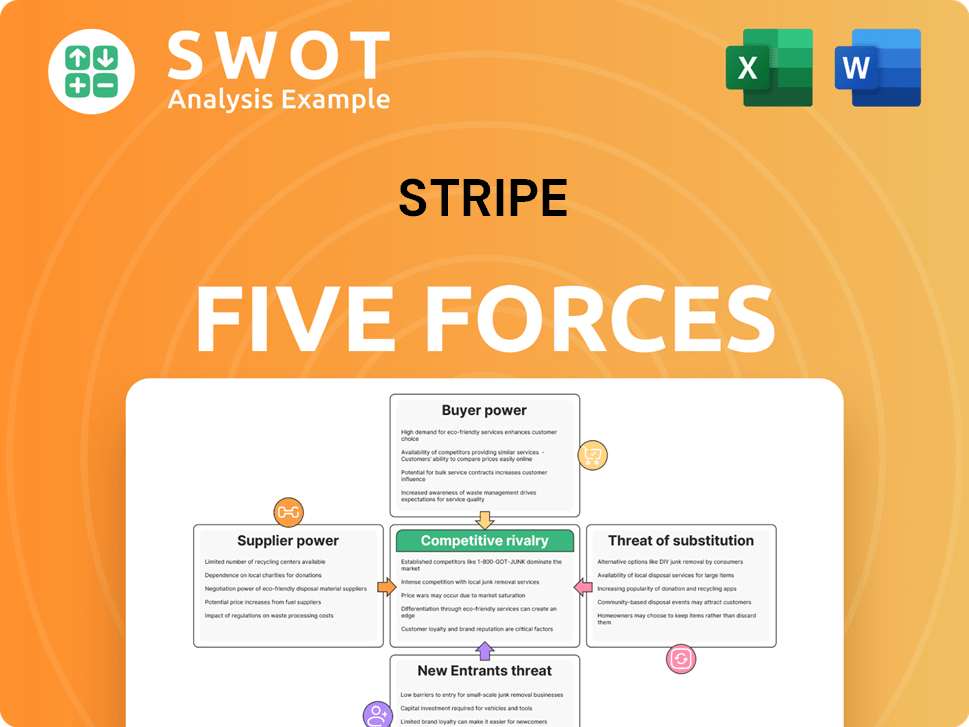
Related Blogs
- What are Mission Vision & Core Values of Stripe Company?
- What is Competitive Landscape of Stripe Company?
- What is Growth Strategy and Future Prospects of Stripe Company?
- How Does Stripe Company Work?
- What is Brief History of Stripe Company?
- Who Owns Stripe Company?
- What is Customer Demographics and Target Market of Stripe Company?
Disclaimer
All information, articles, and product details provided on this website are for general informational and educational purposes only. We do not claim any ownership over, nor do we intend to infringe upon, any trademarks, copyrights, logos, brand names, or other intellectual property mentioned or depicted on this site. Such intellectual property remains the property of its respective owners, and any references here are made solely for identification or informational purposes, without implying any affiliation, endorsement, or partnership.
We make no representations or warranties, express or implied, regarding the accuracy, completeness, or suitability of any content or products presented. Nothing on this website should be construed as legal, tax, investment, financial, medical, or other professional advice. In addition, no part of this site—including articles or product references—constitutes a solicitation, recommendation, endorsement, advertisement, or offer to buy or sell any securities, franchises, or other financial instruments, particularly in jurisdictions where such activity would be unlawful.
All content is of a general nature and may not address the specific circumstances of any individual or entity. It is not a substitute for professional advice or services. Any actions you take based on the information provided here are strictly at your own risk. You accept full responsibility for any decisions or outcomes arising from your use of this website and agree to release us from any liability in connection with your use of, or reliance upon, the content or products found herein.